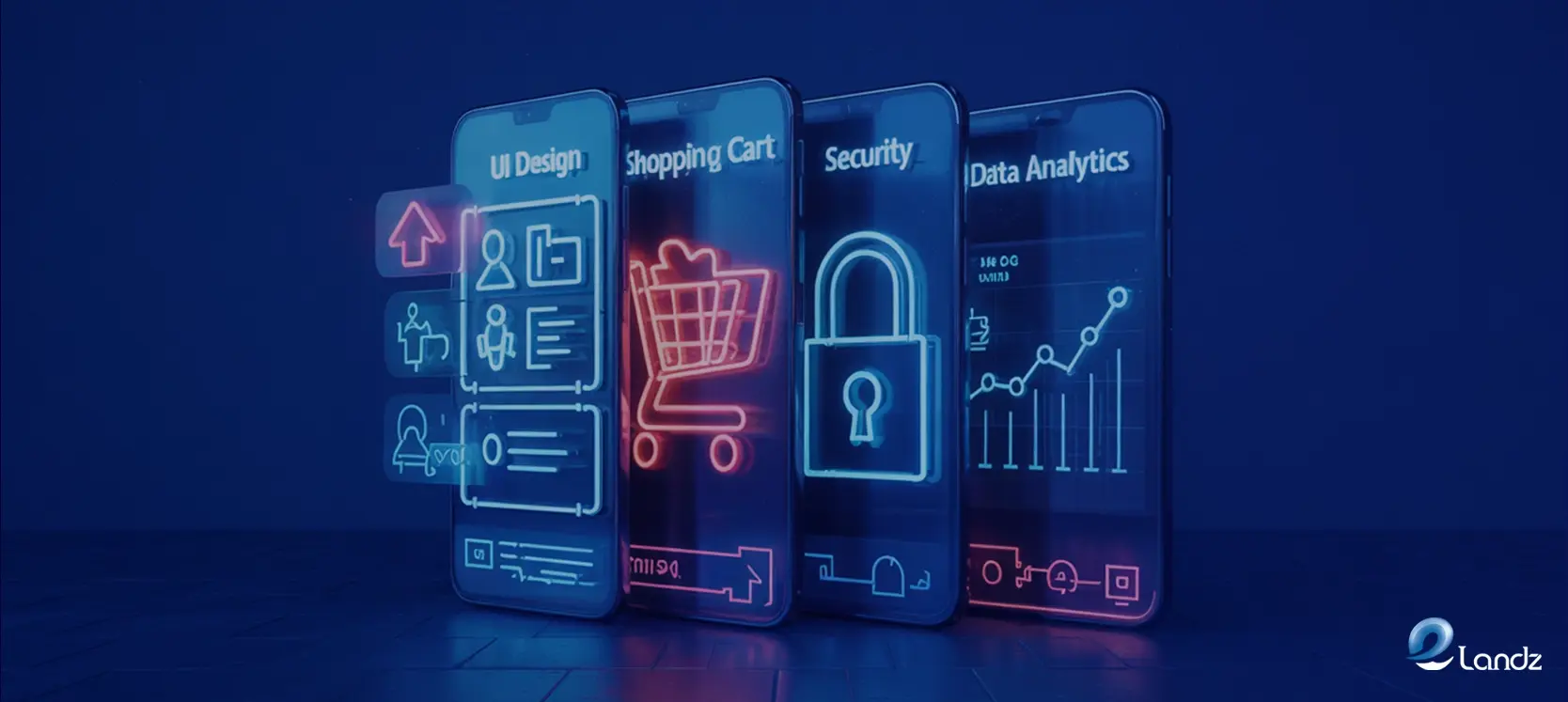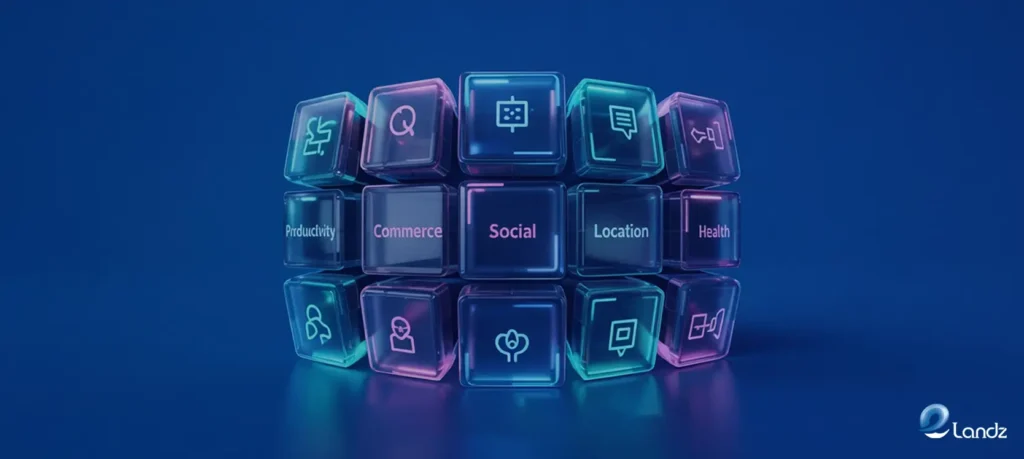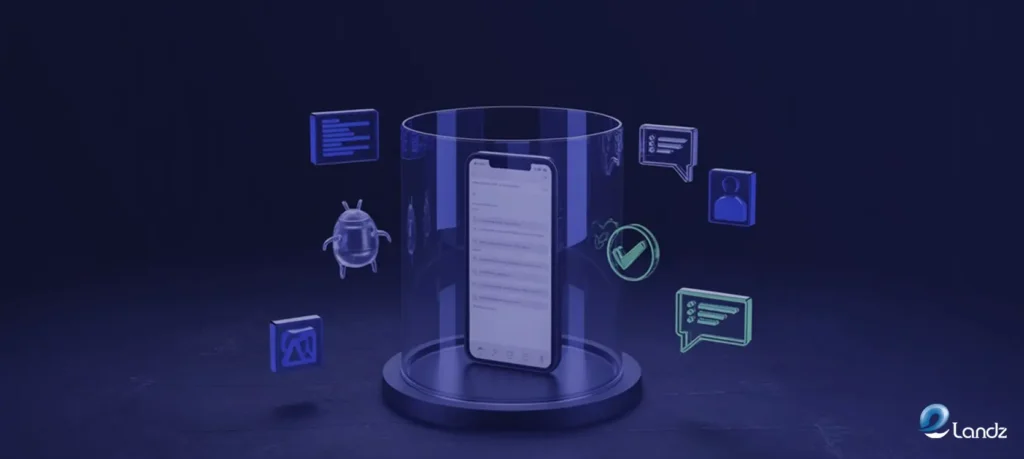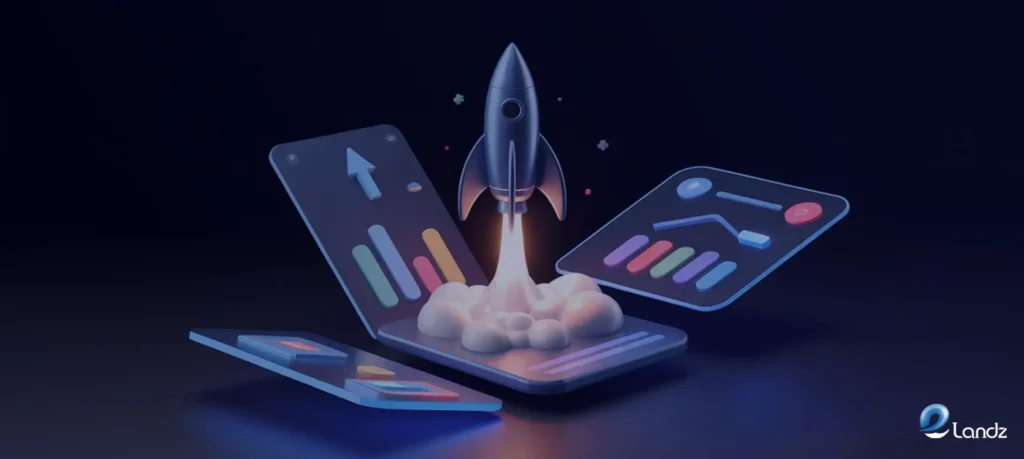
A Complete Guide On How To Develop An Ecommerce Mobile App
30 May 2025Introduction
Are you thinking about releasing your app? Before hiring a development team, it’s wise to have a basic understanding of how to develop an e-commerce mobile app.
Mobile eCommerce sales reached $2.2 trillion in 2023, making up 60% of all global eCommerce sales. This is no less than a necessity for most businesses. In this guide, I will cover all the details.
Establish Clear Business Goals

Before writing a single line of code, determine what you want to achieve. Your goals directly impact feature requirements, development approach, and success metrics. Ask yourself three fundamental questions:
- What specific problems does your app solve?
- Who are you selling to?
- How will you measure success?
If you’re a B2B wholesale company, your priorities differ from those of a B2C fashion retailer. B2B apps need bulk ordering, pricing negotiation, and account management features, while B2C apps might focus on lookbooks, wishlists, and social media integration.
Research Your Target Market
Understanding your audience streamlines development and improves marketing effectiveness. Gather data about your customers’ age, interests, purchasing behavior, and how they discover your brand. This information shapes everything from app design to feature prioritization.
For example, social media integration becomes crucial if your audience consists mainly of millennials. If you serve business customers, focus on fast checkouts and repeat purchase functionality.
Choose the Right Technology Stack
Selecting the right technology foundation determines your app’s performance, development cost, and future scalability. The technology choices you make now will impact every aspect of your app’s functionality and user experience.
Understanding Native Apps vs. Progressive Web Apps
You have two main options: Native Apps and Progressive Web Apps (PWAs). Each serves different business needs and budgets.
You can download these from app stores. They access all phone features like camera, contacts, and photo gallery.
Users can discover your app through app store searches, providing additional marketing opportunities. However, native apps require separate development for iOS and Android.
PWAs work in the same way as websites but offer app-like performance and interactivity. They don’t require app store downloads and work across all platforms. PWAs suit businesses with heavy mobile website traffic or limited budgets.
Platform Selection Considerations
When choosing between iOS and Android, consider where your target audience spends time. For cross-platform development, options include React Native, Flutter, and Xamarin. Each has distinct advantages:
- React Native uses JavaScript and offers faster development.
- Flutter uses Dart and provides excellent performance.
- Xamarin utilizes C# and integrates seamlessly with Microsoft technologies.
Identify Essential App Categories and Features

Not all eCommerce apps serve the same purpose or audience. Understanding different app types and their requirements helps you build features that truly matter to your customers.
Understanding Different eCommerce App Types
The eCommerce app landscape includes several categories, each with unique requirements:
Marketplace Apps connect multiple vendors on one platform. They need vendor management, product listings, secure transactions, and seamless navigation. Examples include Amazon and eBay.
Hyperlocal Apps work within certain geographic areas through quick performance and personalized services. These work well for restaurants, grocery stores, and local service providers.
B2B Wholesale Apps cater to bulk purchasing with features like pricing negotiation, account management, and ERP system integration.
Service and Booking Apps handle appointments and reservations for beauty, healthcare, and home services. They require scheduling systems, service provider management, and secure payment processing.
Core Features Every eCommerce App Needs
Certain features are non-negotiable for eCommerce success:
- Push notifications keep customers engaged and drive repeat purchases. They’re critical for any modern eCommerce app.
- Streamlined checkout process reduces cart abandonment and encourages repeat purchases. One-click payments have become standard expectations.
- Multiple payment options accommodate different customer preferences. US and EU customers expect card payments, while Southeast Asian markets prefer mobile payment options like WeChat.
- Wishlist functionality benefits both B2C and B2B customers. B2B buyers often make repeat purchases, and wishlists speed up the reordering process.
- Review and rating systems build trust through customer feedback. In-app review systems help customers evaluate products before purchasing.
Plan Your Development Approach and Budget
Your development strategy and budget allocation directly impact your app’s success. Making informed decisions about custom development versus ready-made solutions can save significant time and money.
Custom Development vs SaaS Solutions
Your budget and flexibility requirements determine whether to build custom or use SaaS solutions.
Custom Development offers unlimited possibilities and specific integrations but requires significant investment. Large brands like Amazon choose this route for complex requirements and unique features. However, custom apps are expensive to build and maintain, requiring permanent development resources.
SaaS Solutions provide faster deployment at lower costs. Most SaaS platforms include essential eCommerce features like push notifications, one-click checkouts, and easy navigation. They’re ideal for small to medium businesses but offer limited customization options.
Development Cost Factors (INP)
The cost of app development varies according to several factors. These include feature complexity, number of features, target platforms (iOS, Android, or both), UI/UX design complexity, development team location, and backend integration requirements.
Hourly rates differ by location: US and Canada start at $150, Western Europe ranges from $50 to $100, and Eastern Europe offers $35 to $60. Total project costs typically range from $80,000 to $150,000 or more.
Design for User Experience Excellence
Great design separates successful eCommerce apps from failures. Your app’s visual appeal and usability influence customer satisfaction and conversion rates.
Focus on Intuitive Navigation
Great eCommerce apps prioritize user experience above all else. The key to successful apps lies in intuitive design that makes shopping effortless. Poor feature prioritization and a lack of user testing cause most app failures.
Successful apps like GOAT excel in specific areas. GOAT’s search and filter functionality stands out as exceptionally intuitive and easy to use.
Implement Modern Design Trends
Current eCommerce trends focus on bridging online and in-store experiences.
Augmented Reality lets customers visualize products in their environment. IKEA’s augmented reality (AR) functionality enables shoppers to preview how furniture will appear within their living spaces before making a purchase decision.
AI Chatbots provide personalized customer service without overwhelming users. They can be trained on specific business cases to offer highly relevant assistance.
Big Data Integration enables personalized recommendations. Amazon’s success partly stems from predicting customer preferences and suggesting relevant products.
Build and Test Your MVP

The MVP approach reduces development risks while getting your app to market faster. Building the right features first ensures you solve real customer problems without wasting resources.
Start with Essential Features Only
Minimum Viable Product (MVP) development focuses on core functionality that solves user problems. Include only features that provide maximum value to customers. Scalability should be a primary concern when you think about how to develop an e-commerce mobile app. If you hesitate about a feature, it probably shouldn’t be in your MVP.
The MVP approach means it reaches the market earlier. There are reduced development risks, more efficient resource allocation, and early user feedback collection for refinement.
Prioritize Critical Security Measures
ECommerce apps handle sensitive customer information, including addresses, credit card numbers, and phone numbers. Implement robust security measures:
- Private Cloud Storage ensures customer data remains protected from unauthorized access.
- Access Control Rules define who can access specific app features and information.
- Alarm Systems provide immediate threat notifications, allowing quick response to security issues.
Launch and Optimize Your App
Launching your app is just the beginning. Continuous optimization based on user feedback and performance data ensures long-term success and customer satisfaction.
Gather User Feedback Systematically
After the MVP release, collect feedback through multiple channels. Monitor how users interact with your app, capture their suggestions, and identify improvement opportunities. This feedback loop is crucial to make better judgments.
Plan for Scalability from Day One
Your app architecture must handle growing user numbers without performance degradation. Consider scalability during initial development planning, not as an afterthought. This includes choosing scalable hosting solutions and designing efficient database structures. Plus, it also covers planning for increased transaction volumes and implementing load balancing capabilities.
Ensure App Stability and Performance
App crashes and instability drive users away permanently. Maintain stability through regular QA testing, multiple product iterations, continuous user feedback collection, and frequent bug fix releases.
Market Your App Effectively

Even the best eCommerce app fails without proper marketing. Strategic promotion ensures your target audience discovers and downloads your app.
Optimize for App Store Discovery
App store optimization (ASO) helps potential customers find your app. Focus on relevant keywords, compelling descriptions, and attractive screenshots. Remember that 500 million people visit Apple’s App Store weekly, presenting significant discovery opportunities.
Leverage Social Commerce Integration
Social media integration has become essential for eCommerce success. Integrate your products with platforms like Facebook and Instagram, allowing users to purchase while browsing social media. This approach provides personalized experiences that increase customer loyalty and retention.
Use Push Notifications Strategically
Push notifications offer direct access to customers but must be used thoughtfully. Segment your audience and send relevant, timely messages that add value rather than annoy users.
Conclusion
Building a successful eCommerce app requires careful planning, strategic decision-making, and continuous optimization. The mobile commerce boom presents enormous opportunities, but success depends on understanding your audience, choosing appropriate technology, and focusing on user experience.
Start with clear goals, research your market thoroughly, and choose technology that matches your budget and requirements. Build an MVP with essential features, gather user feedback, and iterate based on real user behavior. Remember that successful eCommerce apps evolve continuously, adapting to changing market needs and user expectations.
The investment in mobile eCommerce development pays off through increased customer engagement, higher conversion rates, and expanded market reach. With mobile sales continuing to grow rapidly, startup leaders who delay app development risk falling behind competitors who embrace mobile-first strategies.
For businesses with existing websites, a key question is how to develop an e-commerce mobile app that seamlessly integrates with their current systems. Whether you choose custom development or SaaS solutions, focus on creating genuine value. The most successful apps solve real problems while providing delightful user experiences that keep customers coming back.
FAQs
Here’s what people ask.
What are the requirements for eCommerce app?
An e-commerce app typically requires features like product listings with images and descriptions, user accounts with secure login, a shopping cart, and a secure payment gateway integration.
Additionally, it needs order management, shipping options, and customer support functionalities to facilitate online transactions.
How long does it take to develop an eCommerce app?
It typically takes anywhere from 3 to 12 months or even longer to develop a fully functional e-commerce app.
The exact timeline depends heavily on the app’s complexity, the number of features you want to include, and the development team’s size and expertise.
How much does it cost to develop an e-commerce mobile app?
Understanding the cost is a huge part of learning how to develop an e-commerce mobile app.
Depending on the app’s complexity and features, it can vary widely, typically from $10,000 to $500,000 or even more.
How profitable is a mobile ecommerce app?
Profitability varies greatly depending on factors like the niche, marketing, and user experience.
A well-executed mobile e-commerce app can significantly boost sales and customer loyalty, often leading to higher conversion rates compared to mobile websites.
What is an eCommerce mobile app?
An e-commerce mobile app is a standalone application for smartphones and tablets that allows customers to browse, select, and purchase goods or services online.
Unlike a website, you install an e-commerce app on your device.


